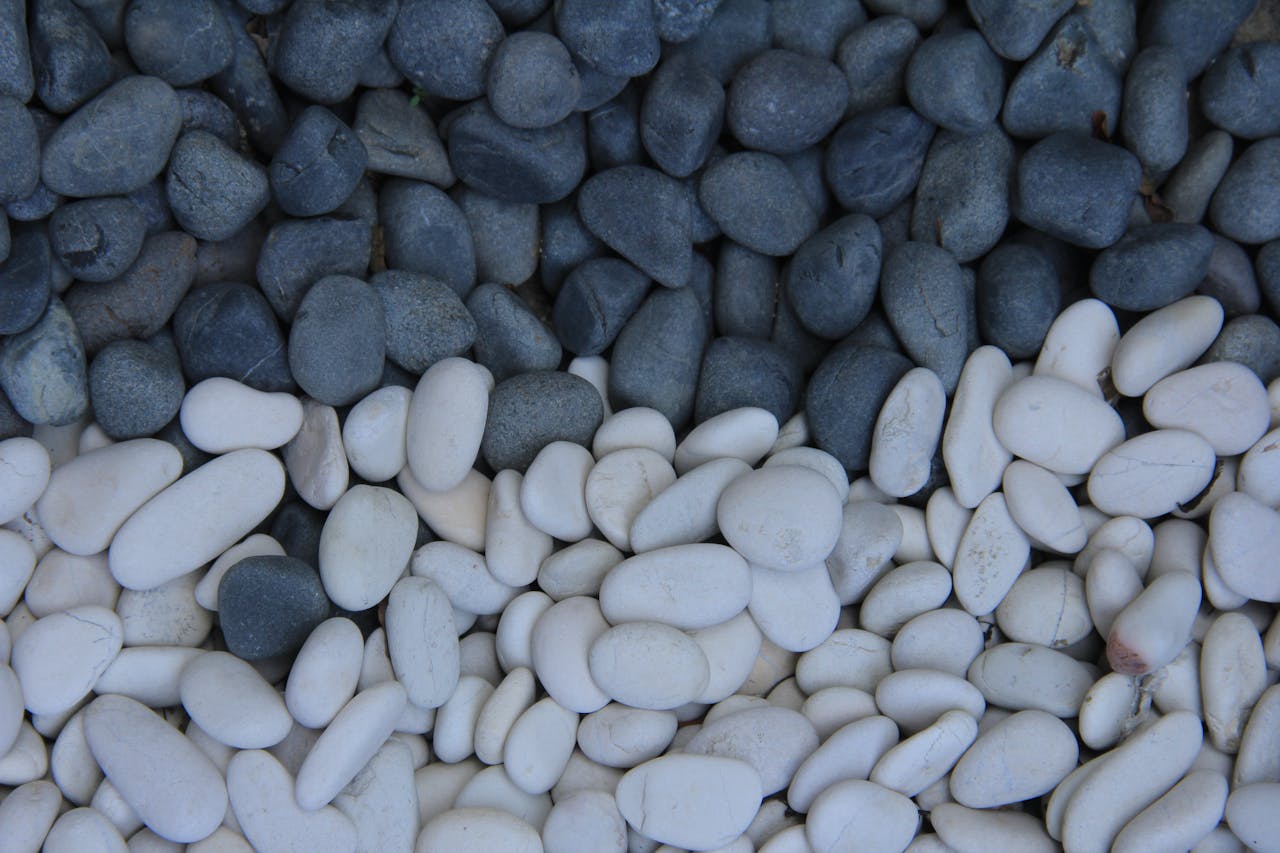White pea gravel comprises small, smooth, rounded stones in a natural white or light colour. It is an attractive and adaptable outdoor landscaping material with many advantages. Its polished appearance goes well with different flora and architectural elements, adding to the garden’s overall beauty. Moreover, white pea gravel is quite adaptable and can be used as a mulch substitute for patios and paths. It is an appealing, eco-friendly, and economically viable option due to its longevity, enhanced drainage capabilities, and low maintenance requirements. To show you why white pea gravel is a great choice for changing your landscape, this piece will go into more detail about these benefits.
Aesthetic Appeal
Its small, smooth, round stones in a light or natural white colour give white pea gravel a polished, clean look that is visually appealing. Garden beds, paths, and other landscaping elements seem better overall because of the visually pleasant contrast that this texture and colour create against earthy tones and green foliage. With a hint of sophistication and elegance, its adaptability makes it a perfect fit for various design aesthetics, from traditional to modern. White pea gravel enhances the cohesiveness and upkeep of outdoor spaces, offering a more hospitable and visually appealing appearance whether it is utilised as a pathway material, a border for flower beds, or the foundation for outdoor seating areas.
Enhancing Visual Contrast
One way to improve visual contrast is to use white pea gravel’s inherent white or light colour to produce a dramatic contrast with the earthy tones of the surrounding elements and the verdant vegetation around it. This contrast draws attention to particular aspects like garden beds, walkways, or architectural focal points and gives the landscape depth and perspective. The gravel’s smooth and rounded texture adds even more visual appeal by providing a polished and clean appearance compared to rougher textures like soil or bark mulch. The beauty and refinement of outdoor spaces can be enhanced by landscapers strategically placing white pea gravel in important spots to create a visually dynamic setting that looks good year-round.
Complementing Various Garden Styles
A common option for improving outdoor aesthetics, white pea gravel is a flexible landscaping material that complements various garden types. In contemporary landscapes, its monochromatic look and consistent colour contrast stylishly with architectural details and well-planned plantings. In conventional landscapes, white pea gravel accentuates the garden’s ageless charm by contrasting with traditional features like wooden fences or stone walkways.
Gravel softens the natural textures of rough stone or aged wood in rustic or cottage-style gardens, bringing light into shady spots and blending in perfectly with unstructured plantings. Its smooth texture makes Asian and Zen gardens feel peaceful, evoking the serenity of classic gravel landscapes. Lastly, white pea gravel blends with bright colours, unique plant arrangements, and creative installations in modern or eclectic garden designs. It acts as a flexible canvas that draws attention to the outside area and strengthens its structural integrity.
Versatility of White Pea Gravel in Landscaping
The remarkable versatility of white pea gravel in landscaping applications can accommodate an enormous range of design requirements and tastes. Its smooth, rounded stones provide a sturdy, aesthetically pleasing surface for bicyclists and walkers, providing practical and aesthetic value to routes. It offers a tidy and welcoming base that goes well with furniture and outdoor décor in outdoor living spaces like patios and keeps drainage issues at bay.
White pea gravel works well as a driveway material, a softer substitute for conventional paving materials, and improves curb appeal. It works wonders as a ground cover, keeping garden beds weed-free and moist while looking nice all year long. It is a flexible option for homeowners and landscapers wishing to easily improve and beautify outdoor spaces because of its adaptability to various design ideas, from modern to rustic.
Low Maintenance
A popular option in landscaping, white pea gravel is highly valued for its low maintenance characteristics. Because of its efficient weed-suppression capabilities, less frequent weeding is required, and its lengthy lifespan means that replacements will only be necessary sometimes. It is less work to maintain its visual appeal over time than organic mulches because it does not disintegrate. Simple cleansing equipment like a leaf blower or rake has a smooth texture that makes it simple to keep the gravel and particles loose.
Its resilience to environmental factors, including rain, daylight, and temperature swings, contributes to its ease of upkeep. It keeps its colour and integrity. White pea gravel reduces the need for fertiliser, watering, and other maintenance costs connected with more demanding ground cover options, making upkeep jobs easier and resulting in long-term cost savings.
Related: https://wellnessbeings.com/aiotechnicalcom-health/
Improved Drainage
Thanks to its capacity to promote effective water percolation and alleviate problems such as soil compaction and erosion, white pea gravel is a great landscaping material for improved drainage. Water can percolate through the porous structure of the gravel to the soil below, avoiding waterlogging and lowering the possibility of root rot or plant stress brought on by standing water. Since clay soils hold water, this property is especially beneficial in locations that frequently get significant rains.
Beyond its usefulness, white pea gravel complements various landscaping styles and offers useful drainage solutions, adding to the visual appeal of outdoor spaces. Because of its adaptability in multiple applications, from paths to garden beds, it will always be a popular option for homeowners and landscapers looking to improve their outdoor spaces aesthetically and functionally.
Durability
Regarding landscaping applications, white pea gravel is widely prized for its resilience. Because of its resistance to wind, rain, and sun exposure, as well as its ability to hold its colour over time, it is an excellent material choice for outdoor projects that will last. White pea gravel doesn’t need to be regularly maintained, unlike organic mulches, which break down and must be replaced more often.
Given that it can withstand foot activity and vehicle use without degrading or losing its drainage characteristics, its resistance to compaction makes it appropriate for high-traffic areas like driveways and walks. Due to its adaptability in several landscaping contexts, white pea gravel is an enduring and low-maintenance choice for augmenting the practicality of outdoor spaces and visual allure.
Eco-Friendly Nature
Several important variables contribute to white pea gravel’s renowned eco-friendliness. The first advantage is that the natural composition of riverbeds or quarries reduces the environmental effect of production and extraction. When compared to the production of synthetic products, this approach usually uses less energy and produces less pollution. Moreover, the porous surface of white pea gravel facilitates rainwater infiltration, refilling groundwater and mitigating runoff that may cause soil erosion and water contamination.
It preserves water quality and fosters healthier soil ecosystems by naturally suppressing weed development, which lessens the need for chemical herbicides. Because of its lifespan and durability, there is less need for replacements, which lowers waste production and the impact on landfills. Considering the values of resource conservation and environmental responsibility, white pea gravel is a sustainable option for landscaping projects because of these qualities.
Temperature Regulation
White pea gravel’s reflecting qualities and thermal characteristics make it an excellent choice for landscaping since they help regulate temperature. White pea gravel helps to maintain colder surface temperatures than darker surfaces like asphalt or conventional mulches because it is a light-coloured material that reflects a large quantity of sunlight instead of absorbing it. White pea gravel’s ability to reflect heat makes places like patios, dining areas, and walking paths coated with the material more comfortable for outdoor activities in the summertime.
Furthermore, it is a thermal buffer in garden beds, regulating soil temperatures and shielding plant roots from intense heat or cold to encourage healthier plant growth. Its beneficial effects on regulating microclimate and reducing the impact of urban heat islands highlight landscaping projects’ role in improving environmental sustainability and outdoor comfort.
Flexibility in Design
This adaptability to various landscaping uses and aesthetic preferences accounts for white pea gravel’s design versatility. This material’s smooth texture and neutral colour allow it to easily incorporate into multiple design styles, including classic, rustic, and minimalist. White pea gravel contributes to the aesthetic appeal of gardens and water features and provides useful advantages like improved drainage and weed suppression.
It is commonly used as a primary material for pathways and walkways, where its small, rounded stones create a pleasing texture underfoot. Because of its adaptability, it may also be used for border and edging applications, creating clear boundaries that efficiently arrange outdoor areas. The versatility of this material enables both homeowners and landscapers to effortlessly personalise their outside spaces, fulfilling both practical and visual goals.
Summary
White pea gravel is a great option for landscaping projects thanks to its many uses and useful qualities. Its clean, cheery appearance adds to the aesthetic appeal of outdoor settings as it blends effortlessly with different building styles and garden layouts. In addition to its aesthetic value, white pea gravel facilitates healthier plant growth and sustainable gardening techniques by enhancing drainage and lowering soil erosion.
Over time, it becomes more affordable because of its longevity, guaranteeing long-lasting performance with less upkeep. White pea gravel offers various design possibilities, enabling homeowners and landscapers to create unique, practical landscapes that value aesthetics and practicality. It can be utilised for paths, garden borders, or decorative accents. In addition to improving curb appeal, using white pea gravel in your next landscaping project helps create a low-maintenance and sustainable outdoor space.



